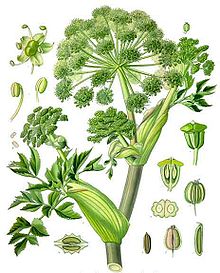
Back Engelkruid Afrikaans عشبة الملاك المخزنية Arabic انجليكا ارخانجيلكا ARZ Angelica archangelica AST Dərman tütəkcəsi Azerbaijani Дзягіль лекавы Byelorussian Градинска ангелика Bulgarian Angèlica Catalan Angelica archangelica CEB Andělika lékařská Czech
| Angelica archangelica | |
|---|---|

| |
| Scientific classification | |
| Kingdom: | Plantae |
| Clade: | Tracheophytes |
| Clade: | Angiosperms |
| Clade: | Eudicots |
| Clade: | Asterids |
| Order: | Apiales |
| Family: | Apiaceae |
| Genus: | Angelica |
| Species: | A. archangelica
|
| Binomial name | |
| Angelica archangelica | |
| Synonyms[2] | |
|
Synonyms list
| |
Angelica archangelica, commonly known as angelica,[3] garden angelica, wild celery, and Norwegian angelica, is a biennial plant from the family Apiaceae, a subspecies of which is cultivated for its sweetly scented edible stems and roots. Like several other species in Apiaceae, its appearance is similar to several poisonous species (Conium, Heracleum, and others), and should not be consumed unless it has been identified with absolute certainty. Synonyms include Archangelica officinalis Hoffm. and Angelica officinalis Moench.[4]
- ^ "Angelica archangelica". Germplasm Resources Information Network. Agricultural Research Service, United States Department of Agriculture. Retrieved 2008-03-03.
- ^ "Angelica archangelica L." Plants of the World Online. Board of Trustees of the Royal Botanic Gardens, Kew. 2017. Retrieved 11 July 2020.
- ^ "Angelica archangelica". RHS. Retrieved 2 September 2023.
- ^ "Angelica archangelica L. | Plants of the World Online | Kew Science". Plants of the World Online. Retrieved 2018-07-30.